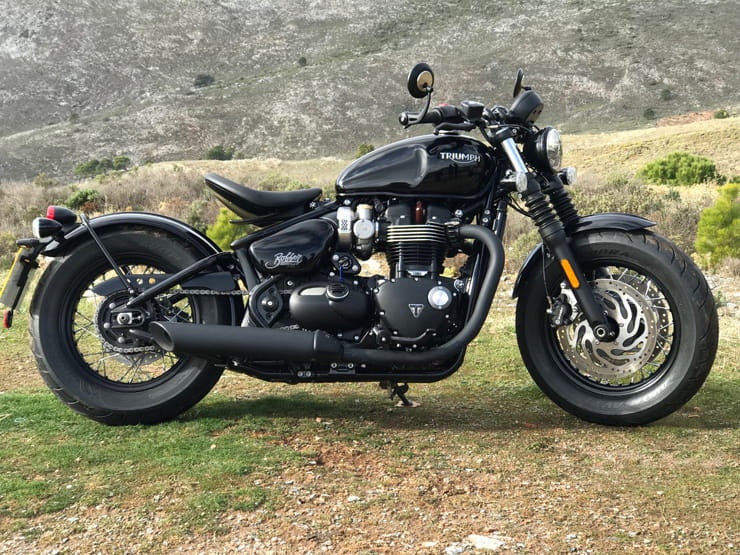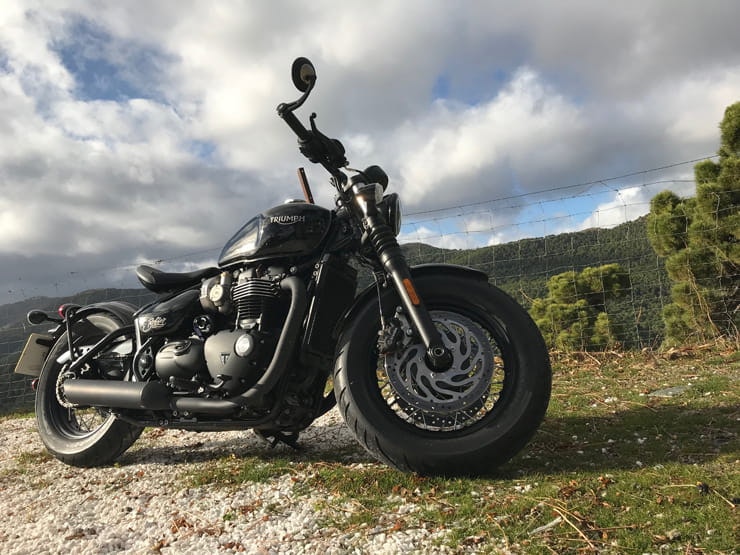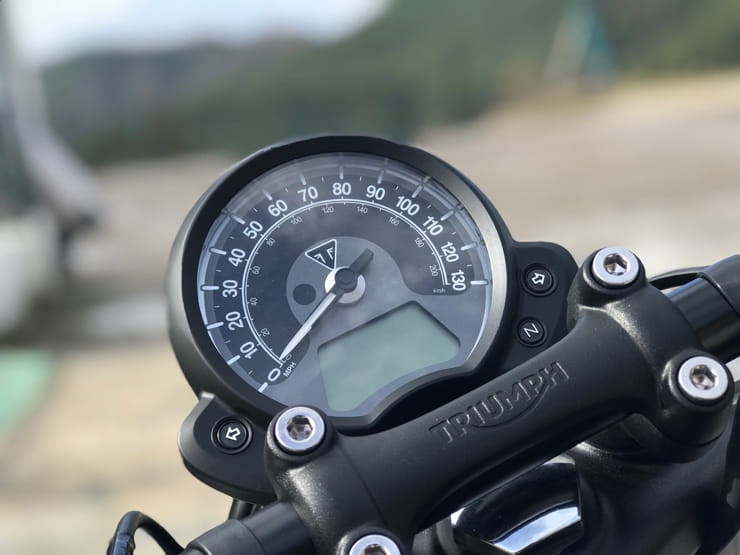Triumph Bobber Black (2018) - Review
By Simon Hancocks
Motorcycle Journalist
15.12.2017
KIT CREDITS
Helmet
Shark Drak | £239.99
Jacket
Richa Daytona | £269.99
Jeans
Furygan Jeans | £129.99
Boots
Furygan Ted | £109.99
Gloves
Furygan TD12 | £49.99
To say that Triumph’s Bobber range is a success is an understatement; it is officially Triumph’s fastest selling motorcycle to date. The current market for bikes is led by machines that are either cheap, economical commuter machines or big heavy adventurers; taking this into account makes the success of this niche styled – and slightly impractical – bike all the more impressive.
Announcing a new Bobber Black just 12-months after the original machine broke onto the scene confused some; if it isn’t broke don’t fix it after all, but was there more to this new model than a mere styling exercise?
What’s new?
To look at, the Black is basically the same as the previous bike, at 50-paces you’d be hard pushed to tell them apart. The biggest and most easily spotted difference is the front wheel – down from 19” diameter to 16” and fitted with a chunky 130/90 Avon Cobra tyre. At a glance this makes the front and rear wheels almost the same size and gives the bike a much more aggressive stance than the previous model. It’s worth noting that the rolling circumference is virtually identical to the original Bobber so the rake of the bike and headstock height remain unchanged.
Further alterations at the front come in the form of fatter 47mm Showa cartridge forks that replace the smaller and slightly lower-spec 41mm KYBs of the standard bike. The Black also benefits from twin 310mm discs, which are equipped with Brembo two-piston calipers. The new bike also features a very cool looking LED daytime riding light that is on permanently; it’s a nice touch that lifts the front end and means you’ll be more visible when riding in gloomy conditions. The Black is priced at £11,650 while the standard Bobber is £10,600.
How does it look?
As with all Triumph’s Black edition bikes, there are only two colours available; matte and gloss black.
Styling wise I reckon it looks great (I know the Bobber has been a bit of a Marmite bike). The black paint and that fat front tyre completely change the look of the bike; It’s more aggressive and suits a younger, edgier and more urban setting, perfectly in keeping with the current boom in café-racer culture and custom bikes. The Black has coated black engine casings, black air-box cover, fuel-tank and mudguards. The only brushed metal is the cooling fins on the head and some tiny engine details.
What’s it like to ride?
To start with, the riding day of the launch didn’t look to be running to plan… Normally at this time of year Malaga is bathed in sunshine with the mercury hitting the twenties. On the day of the launch I was sat in the hotel foyer rummaging through a box of Triumph-branded water-proofs, trying to find some that weren’t XXL. With the rain not stopping until about one o’clock, the planned and relaxed day of cruising the hills to the north became a more concentrated affair, with short rides and coffee stops punctuated by photos and videos. First we rode about 20km from the hotel through Malaga to the start of the mountain roads. This kind of riding was great for the start of the launch as it gave me a chance to check out the bike in real-world conditions. And I knew what to look for; I’d spent about 10-days riding the Touring Bobber to and from work, and for me the only real let down was the front brake. Burbling between roundabouts in the town I was leaving my braking intentionally late and really grabbing the lever to see how the new Brembo setup behaved. The brakes are greatly improved in both feel and performance. The single disc Bobber has a vague feeling lever that needs a four-finger pull to haul the bike up from speed. The Black has a progressive lever that you can feel right from the slightest touch as the front tyre bites into the road. It gave me more confidence not just when riding round town but also on more flowing stretches; you can brake with just one finger and the big front tyre gives plenty of grip, allowing you to trail brake into turns if needed.
The main part of the ride was along a stretch of road that leads from Malaga to the village of Ronda; it is stunning, if you haven’t been before start planning a trip and go! Its 80km of winding switchbacks and fast flowing stretches that takes you nearly 800-metres from sea level to to the summit. The corners are cambered meaning you can carry quite a bit of corner speed but the surface in places can be cracked and slippery. The Black handled it all very well, the fatter tyre and higher-spec front suspension being noticeably better at absorbing bumps in the road than the previous machine, and I found the handling very predictable and safe. On a couple of occasions I’d push the bike too hard into a corner to see how it reacted, it would just ever-so-gently push wide in a controlled manner. There were no nasty surprises it was all very calm and predictable. Ground clearance is still a limiting factor – I think most of the bikes came back with foot pegs that’d been introduced to the Spanish roads – but if you’re looking for a bike to go chasing apexes, this is not the machine – or sector of the market – for you!
So does the new front tyre affect the handling?
The answer is yes. A bit. Look, it’s a big chunk of rubber up front that has an extra caliper and disc bolted to it; all in that adds 9.5kg to the weight of the bike. But that’s not 9.5kg to the seat engine or frame, that’s 9.5kg of unsprung weight. I found the bike was less flickable and you did have to heave it into the faster corners. There are some plus points to the new front end arrangement though; I found the Triumph to be extremely stable on the brakes and under acceleration. I had the traction control cutting in when coming out of some faster corners and the Black was completely solid; there was no movement through the bars or complaint from the chassis.
The Black features the same 1200cc parallel twin that powers the rest of the range and it’s a peach. It’s got bags of useable torque that Triumph claims is a class-leading 106Nm (78lb-ft) and it carries it from 3,500rpm right through until 5,500rpm. The engine is really torquey so perfectly suited to this kind of bike.
The gearbox is light to use, precise and well matched to the engine. The exhaust note on the bike I rode was lovely; it had the standard exhausts not the Vance and Hines optional ones I had on the touring Bobber… I’m not sure I could honestly tell the difference! The exhausts exit just below and to the rear of the seat meaning the bark from the engine is really noticeable, especially as it reverberated off the stone walls of the Ronda road.
What equipment does it have?
Not a lot, but it is a Bobber after all and anyway, the purists would be up in arms if it had too much. The Triumph option catalogue is bursting at the seams though. There are over 100 parts that you can bolt on to your Bob’. Everything from funky saddle-bags to forward-mounted foot-rests. The entire options list is designed for the Bobber and homologated for the bike meaning no warranty issues. The one I rode had the optional heated grips, which were extremely hot. I’m not exaggerating when I say that moving a bike at the petrol station without gloves on actually made me wince!
The cruise control on the Black was mostly redundant due to the type of roads we were riding but when on dual carriageways it was a welcome relief to be able to rest my right hand. The system is controlled by a single button on the left handlebar and is very simple to use. One click primes the system, another will lock the bike at that speed. Press either brake or open the throttle again and it’s disabled – simple.
The Black’s dash has the same features as before; digital RPM, MPG (I saw about 40mpg after 150km of spirited riding), trip computer, ODO, time, traction control settings and cruise control but what’s the point? All I really needed was to see that big needle on the rev-counter rushing round the dial as the trees became a blur.
Triumph Bobber Black (2018) | BikeSocial launch review
BikeSocial reviews Triumphs latest version of the highly popular Bobber
Conclusion
The Bobber Black is a fantastic bike in so many ways. It’s more than a styling exercise… it’s an upgrade and the first of the Black editions to get upgraded parts. But why? Was the original Bobber flawed? In my eyes, yes, but only slightly. I feel that Triumph has taken the opportunity it had with the Black to address the main issue with the original bike; its front brake.
In the process it has created a motorcycle that has a completely different vibe to the original Bobber. It’s darker, moodier and the fact that it’s now slightly harder to push into a corner might even make is a bit ‘badder’. In a good way! Custom bikes and café racers shouldn’t be pussycats, nobody is stripping Pan-Europeans back to the frame and slapping some moon-eyes stickers on the headlight, because Pan-Europeans are soft and compliant and do what you want. Bobbers rebel. A bit!
The Bobber Black is also a blank/black canvas for customisation; it’s crying out for some bespoke parts, yellow headlight bulbs and wrapped pipes. I give it a month before that fat front tyre is wheeled out of some custom speed-shop looking every inch the ‘shed-built’ machine that the current market is craving.
For more information on the Triumph Bobber Black and the rest of the range, click here.
Tech spec:
Type Liquid cooled, 8 valve, SOHC, 270° crank angle parallel twin
Capacity 1200 cc
Bore Stroke 97.6 / 80mm
Compression 10.0:1
Max Power 76 Bhp (57 kW) @ 6,100 rpm
Max Torque 106 Nm (78lb-ft) @ 4,000 rpm
System Multipoint sequential electronic fuel injection
Exhaust Chromed stainless steel 2 into 2 twin-skin exhaust system black finish
Final drive Chain
Clutch Wet, multi-plate assist clutch
Gearbox 6-speed
Frame Tubular steel cradle
Swingarm Twin-sided, tubular steel
Front Wheels 32-spoke, 16 x 2.5in
Rear Wheels 32-spoke, 16 x 3.5in
Front Tyres 130/90 B16
Rear Tyres 150/80 R16
Suspension:
Front Showa 47 mm forks with cartridge damping, 90 mm travel.
Rear KYB monoshock with linkage, 77 mm travel
Brakes:
Front Twin 310 mm disc, Brembo 2-piston floating calipers, ABS
Rear Single 255 mm disc, Nissin single piston floating caliper, ABS
Height 1025 mm
Seat Height 690 mm
Wheelbase 1510 mm
Rake 25.8º
Trail 87.9 mm
Dry Weight 237.5 Kg
Tank Capacity 9L
For a competitive insurance quote click here
Share on social media:


